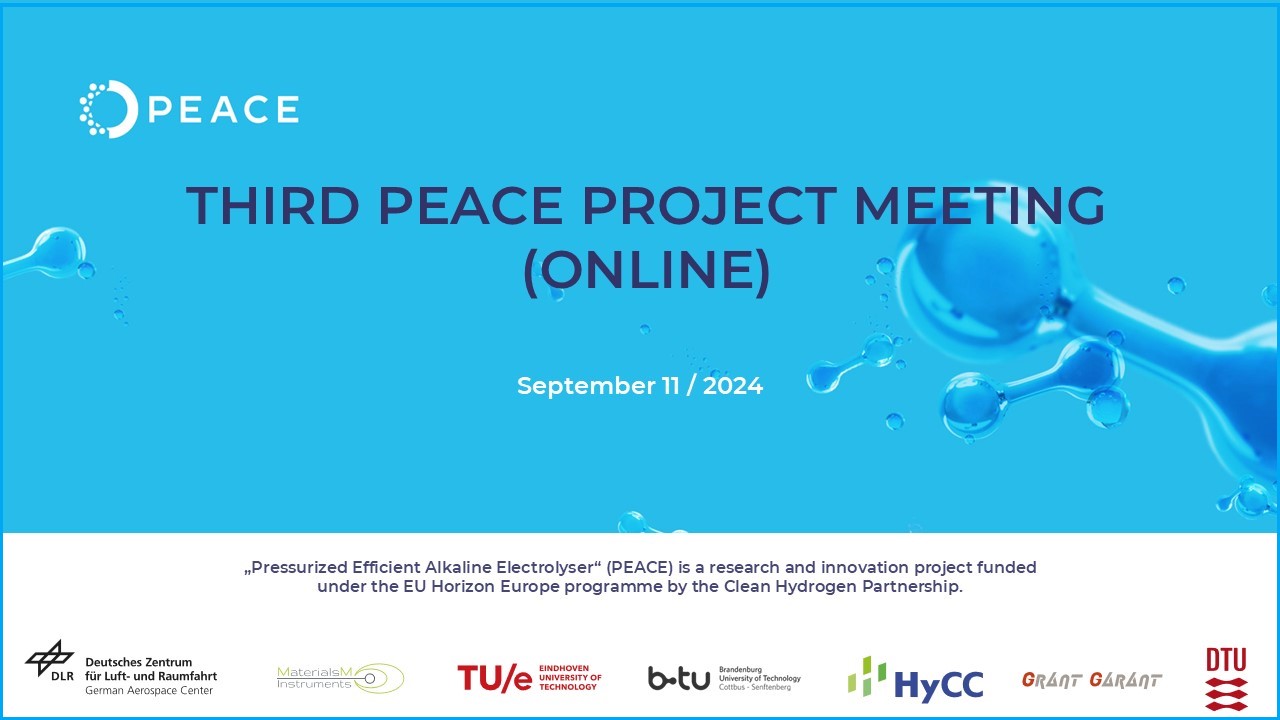3rd PEACE Project Meeting: Getting Ready To Achieve our Research Targets
Published: October 15, 2024
THIRD PEACE PROJECT MEETING
An online meeting full of deep discussions, brainstorming, and knowledge sharing
In mid-September 2024, the PEACE project held its third all-hands project meeting. We gathered online to assess the progress of our research and innovation efforts, which aim to develop a highly pressurized alkaline electrolysis (AEL) technology. This technology is expected to reduce the cost of (green) hydrogen production and its subsequent utilisation.
One of the key aspects of the meeting was the intensive exchange of ideas, as we prepare to achieve two major research targets in November 2024: (1) the qualification of cell components, including substrates, diaphragms, and membranes; and (2) the design and production of stack components for high-pressure AEL operation
The meeting was organized by the Coordinator, Dr. Fatemeh Razmjooei, Institute of Engineering Thermodynamics at German Aerospace Center (DLR), who provided a comprehensive overview of the goals met so far and the challenges that lie ahead. PEACE has successfully delivered eight reports to the Clean Hydrogen Partnership (the granting authority), all in accordance with the project plan.

Presentations of WP2 teams of TU/e and DLR offered a direct comparison of results from their electrochemical testing on cell/stack components. They presented preliminary findings, which led to an In-depth discussion on the performance of the related result. The high-performance benchmark of 1 A/cm2 at 1.8V is fulfilled. Tested separators demonstrated comparable and reasonable gas purity within a specific current density range. WP2 is now gearing up for final testing, with results to be summarised in a deliverable report by the end of November.
In WP3, MMI provided an update on the development and qualification of stack components. Their efforts include launching the operation of the gantry mill and optimizing the production of end plates for better pressure-to-weight performance. Gasketing issue has been resolved, and the full stack design is progressing smoothly.
BTU, leading the WP4 and hosting the PEACE AEL stack demonstrator, presented the status of their stack readiness, with DEKRA Test and Pressure Certification recently achieved. The team also shared and discussed the Piping and Instrumentation diagram (P&ID) for the high-pressure setup.
The WP5 team at DLR has successfully developed simulation scenarios for the PEACE AEL system. They are currently working with the TEMPEST modelling framework to complete the PEACE electrolyser system (pressure vessel and other BoP parts). In parallel, they are defining operating strategies to ensure safe and efficient transitions between nominal and part load operation modes while maintaining high gas purity during partial load and rapid power changes (e.g. when renewable energy sources are involved).
Lastly, GG provided updates on the ongoing PEACE communication campaign. The PEACE website is regularly fed updated with news, and PEACE’s active presence on social media (PEACE X and LinkedIn profile) has contributed to growing engagement and increasing the visibility of the project’s impact.
In summary, the PEACE project is on track, with significant progress made towards its first scientific outputs, expected in the coming months. Stay tuned for more updates!

The project is supported by
the Clean Hydrogen Partnership and its members.

Co-funded by the European Union. Views and opinions expressed are however those of the author(s) only and do not necessarily reflect those of the European Union or Clean Hydrogen Partnership. Neither the European Union nor the granting authority can be held responsible for them.